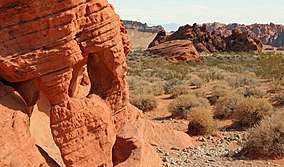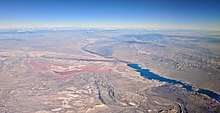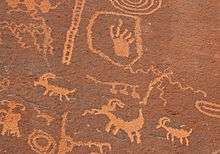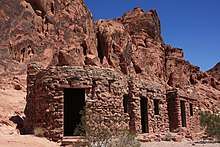Valley of Fire State Park
Valley of Fire State Park is a public recreation and nature preservation area covering nearly 46,000 acres (19,000 ha) located 16 miles (26 km) south of Overton, Nevada.[3] The state park derives its name from red sandstone formations, the Aztec Sandstone, which formed from shifting sand dunes 150 million years ago.[4] These features, which are the centerpiece of the park's attractions, often appear to be on fire when reflecting the sun's rays.[5] It is Nevada's oldest state park, as commemorated with Nevada Historical Marker #150.[6] It was designated as a National Natural Landmark in 1968.[7]
| Valley of Fire State Park | |
|---|---|
 | |
 Location in the United States  Location in Nevada | |
| Location | Clark County, Nevada, United States |
| Nearest town | Overton, Nevada |
| Coordinates | 36°27′22″N 114°31′59″W[1] |
| Area | 45,937.88 acres (185.9040 km2)[2] |
| Elevation | 2,464 ft (751 m)[1] |
| Designation | Nevada state park |
| Established | 1935 |
| Administrator | Nevada Division of State Parks |
| Website | Valley of Fire State Park |
| Designated | 1968 |
Nevada Historical Marker | |
| Reference no. | 150 |
Valley of Fire is located 50 miles (80 km) northeast of Las Vegas, at an elevation between 1,320–3,009 feet (402–917 m).[4] It abuts the Lake Mead National Recreation Area on the east at the Virgin River confluence. It lies in a 4 by 6 mi (6.4 by 9.7 km) basin.
Geology

Complex uplifting and faulting of the region, followed by extensive erosion, have created the present landscape. The rough floor and jagged walls of the park contain brilliant formations of eroded sandstone and sand dunes more than 150 million years old. Other important rock formations include limestones, shales, and conglomerates.[4]
History

Prehistoric inhabitants of the Valley of Fire included the Ancestral Puebloans, also known as the Anasazi, who were farmers from the nearby fertile Moapa Valley. Their approximate span of occupation has been dated from 300 BC to 1150 AD. Their visits probably involved hunting, food gathering, and religious ceremonies, although scarcity of water would have limited their stay. Fine examples of rock art (petroglyphs) left by these ancient peoples can be found at several sites within the park.[4]
The creation of Valley of Fire State Park began with transfer of 8,760 acres (3,550 ha) of federal land to the state of Nevada in 1931.[6] Work on the park was initiated by the Civilian Conservation Corps in 1933. During the years of their employment, which continued into the early 1940s, the CCC workers built campgrounds, trails, stone visitor cabins, ramadas, and roads.[8] The park opened in 1934; it achieved official designation by the state legislature in 1935.[5]
Climate
The Valley of Fire State Park has a dry and warm climate typical of the Mojave Desert in which it lies. Winters are mild with daytime temperatures ranging from 54 °F (12 °C) to 75 °F (24 °C). and over night lows in the mid 30 °F's to mid 40 °F's (3-8 °C). Storms moving east from the Pacific Ocean occasionally bring rain during winter months. Daily summer highs usually range from 100 °F (38 °C) to 115 °F (46 °C) and on occasion may reach near 120 °F (49 °C). Thunderstorms from the Southwestern Monsoon can produce heavy showers during summer. The average annual precipitation is 6.50" (165.1mm).
| Climate data for Valley of Fire SP, Nevada | |||||||||||||
|---|---|---|---|---|---|---|---|---|---|---|---|---|---|
| Month | Jan | Feb | Mar | Apr | May | Jun | Jul | Aug | Sep | Oct | Nov | Dec | Year |
| Record high °F (°C) | 74 (23) |
87 (31) |
93 (34) |
100 (38) |
111 (44) |
117 (47) |
117 (47) |
115 (46) |
110 (43) |
102 (39) |
87 (31) |
74 (23) |
117 (47) |
| Average high °F (°C) | 58.0 (14.4) |
62.4 (16.9) |
70.5 (21.4) |
79.3 (26.3) |
89.9 (32.2) |
100.0 (37.8) |
105.4 (40.8) |
103.3 (39.6) |
95.8 (35.4) |
81.9 (27.7) |
67.2 (19.6) |
57.0 (13.9) |
81.0 (27.2) |
| Average low °F (°C) | 38.9 (3.8) |
42.9 (6.1) |
48.4 (9.1) |
55.1 (12.8) |
64.8 (18.2) |
74.2 (23.4) |
80.8 (27.1) |
78.8 (26.0) |
71.0 (21.7) |
58.7 (14.8) |
46.7 (8.2) |
38.3 (3.5) |
58.3 (14.6) |
| Record low °F (°C) | 19 (−7) |
18 (−8) |
29 (−2) |
29 (−2) |
42 (6) |
48 (9) |
60 (16) |
61 (16) |
49 (9) |
38 (3) |
19 (−7) |
12 (−11) |
12 (−11) |
| Average precipitation inches (mm) | 0.83 (21) |
1.05 (27) |
0.81 (21) |
0.24 (6.1) |
0.10 (2.5) |
0.10 (2.5) |
0.62 (16) |
0.64 (16) |
0.34 (8.6) |
0.52 (13) |
0.49 (12) |
0.76 (19) |
6.50 (165) |
| Source: Western Regional Climate Center[9] | |||||||||||||
Valley of Fire Road

Valley of Fire Road is the main road accessing and traversing through the park. The 10.5-mile (16.9 km) section of the road between the east and west entrances of the park was officially designated as a Nevada Scenic Byway on June 30, 1995.[10]
Activities and amenities
The park has a visitors center plus facilities for picnicking, camping, and hiking.[3] Petroglyphs are seen throughout the park, with Mouse's Tank and Atlatl Rock two areas in particular with numerous petroglyphs that are relatively easily accessible.[4] The park also preserves three stone cabins built by the Civilian Conservation Corps.
Film history

Valley of Fire is a popular location for shooting automobile commercials and other commercial photography. It has provided a setting for the following films and television shows:
- Viva Las Vegas starring Elvis Presley had multiple shots filmed in the park during the racing scenes for the film's finale in 1963.
- The Professionals with Burt Lancaster, Lee Marvin, and Claudia Cardinale was filmed in 1966. Valley of Fire was one of three locations used in the film. All that remains of the set is a portion of a rock wall of a hacienda.[11]
- The outside Mars scenes from Total Recall, starring Arnold Schwarzenegger, were almost totally shot in Valley of Fire.[12]
- The scenes from planet Veridian III from Star Trek Generations were filmed here in 1994.[13] The Silica Dome is particularly highlighted for Star Trek fans as the site of iconic starship captain James T. Kirk's death and burial.
See also

- Red Rock Canyon National Conservation Area
- Little Finland and Gold Butte Backcountry Byway
- Moapa River Indian Reservation
References
- "Valley of Fire State Park". Geographic Names Information System. United States Geological Survey.
- "Inventory of State Lands" (PDF). Nevada Division of State Lands. April 27, 2018. Retrieved November 25, 2019.
- "Valley of Fire State Park". Nevada State Parks. Department of Conservation and Natural Resources. Retrieved January 24, 2017.
- "Valley of Fire State Park General Management Plan 2010" (PDF). Nevada Division of State Parks. Archived from the original (PDF) on August 13, 2012. Retrieved August 4, 2016.
- "History of Valley of Fire State Park". Nevada State Parks. Department of Conservation and Natural Resources. Retrieved January 24, 2017.
- "Nevada's First State Park". Nevada’s State Historical Markers. State Historic Preservation Office. Retrieved January 24, 2017.
- "Valley of Fire". National Natural Landmarks. National Park Service. Retrieved January 24, 2017.
- Renee Corona Kolvet; Victoria Ford (2006). The Civilian Conservation Corps in Nevada: From Boys to Men. University of Nevada Press. pp. 101–102. ISBN 978-0-87417-676-6. Retrieved May 3, 2017.
- "1981–2010 Monthly Normals for Valley of Fire SP, Nevada". Western Regional Climate Center. Retrieved November 26, 2016.
- "Nevada's Scenic Byways". Nevada Department of Transportation. Archived from the original on May 17, 2014. Retrieved September 19, 2008.
- Carlo Gaberscek, Kenny Stier (2014). In Search of Western Movie Sites. Jerry Schneider Enterprises. p. 140. ISBN 978-1312625020. Retrieved August 3, 2016.
- "Scene in Nevada: Total Recall". Nevada Film Office. Retrieved July 7, 2016.
- Diane L. Winslow; Jeffrey R. Wedding (2009). "Moapa Valley Trails Study Pre-Design Existing Data Review" (PDF). University of Nevada. p. 50. Retrieved May 3, 2017.
External links
| Wikimedia Commons has media related to: |
- Valley of Fire State Park Nevada State Parks
- Valley of Fire State Park Trail Map Nevada State Parks